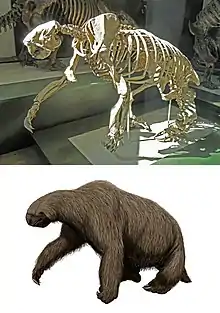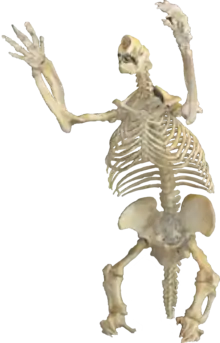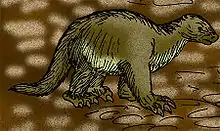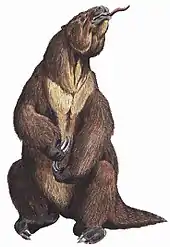Megalonychidae
Megalonychidae is a group of sloths including the extinct Megalonyx. Megalonychids first appeared in the early Oligocene, about 35 million years (Ma) ago, in southern Argentina (Patagonia).[1] There is actually one possible find dating to the Eocene, about 40 Ma ago, on Seymour Island in Antarctica (which was then still connected to South America).[2] They first reached North America by island-hopping across the Central American Seaway, about 9 million years ago,[3] prior to formation of the Isthmus of Panama about 2.7 million years ago (which led to the main pulse of the Great American Interchange). Some megalonychid lineages increased in size as time passed. The first species of these were small and may have been partly tree-dwelling, whereas the Pliocene (about 5 to 2 million years ago) species were already approximately half the size of the huge Late Pleistocene Megalonyx jeffersonii from the last ice age.[4]
| Megalonychidae | |
|---|---|
 | |
| Megalonyx wheatleyi skeleton and restoration | |
| Scientific classification | |
| Kingdom: | Animalia |
| Phylum: | Chordata |
| Class: | Mammalia |
| Order: | Pilosa |
| Suborder: | Folivora |
| Family: | †Megalonychidae Gervais 1855 |
| Subfossil genera | |
|
Fossil genera, see text | |
It was formerly believed, based on morphological comparisons, that Greater Antilles sloths and extant arboreal two-toed sloths were part of this family. However, molecular results based on sequences from collagen[5] and mitochondrial DNA[6] have shown that the former represent a basal branch of the sloth radiation, while the latter are more closely related to mylodontid sloths. The megalonychids plus nothrotheriid and megatheriid sloths, together with living three-toed sloths, make up the sloth superfamily Megatheroidea.[5][6]
Megalonychid ground sloths became extinct in North and South America around the end of the Pleistocene.[7]
Evolution

Megalonyx, which means "giant claw", is a widespread North American genus that lived past the close of the last (Wisconsin) glaciation, when so many large mammals died out. Remains have been found as far north as Alaska and the Yukon.[8][9] Ongoing excavations at Tarkio Valley in southwest Iowa may reveal something of the familial life of Megalonyx. An adult was found in direct association with two juveniles of different ages, suggesting that adults cared for young of different generations.[10][11]
The earliest known North American megalonychid, Pliometanastes protistus, lived in Florida and the southern U.S. about 9 million years ago, and is believed to have been the predecessor of Megalonyx. Several species of Megalonyx have been named; in fact, a 2000 article by Harington et al. in Arctic claimed that "nearly every good specimen has been described as a different species".[8] A broader perspective on the group, accounting for age, sex, individual and geographic differences, indicates that only three species are valid (M. leptostomus, M. wheatleyi, and M. jeffersonii) in the late Pliocene and Pleistocene of North America.[12] Although work by McDonald lists five species.
Jefferson's ground sloth has a special place in modern paleontology, for Thomas Jefferson's letter on Megalonyx, read before the American Philosophical Society of Philadelphia, in August 1796, marked the beginning of vertebrate paleontology in North America.[8] When Lewis and Clark set out, Jefferson instructed Meriwether Lewis to keep an eye out for ground sloths. He was hoping they would find some living in the Western range. Megalonyx jeffersonii was consequently named after Thomas Jefferson.[8]
Taxonomy
Family Megalonychidae Gervais 1855
|
|
Phylogeny
The following sloth family phylogenetic tree is based on collagen and mitochondrial DNA sequence data (see Fig. 4 of Presslee et al., 2019).[5]
| Folivora |
| |||||||||||||||||||||||||||||||||||||||||||||||||||||||||||||||||
References
| Wikispecies has information related to Megalonychidae. |
- Morgan, Gary S. (2002). "Late Rancholabrean Mammals from Southernmost Florida, and the Neotropical Influence in Florida Pleistocene Faunas". In Emry, Robert J. (ed.). Cenozoic Mammals of Land and Sea: Tributes to the Career of Clayton E. Ray. Smithsonian Contributions to Paleobiology. 93. Washington, D.C.: Smithsonian Institution Press. pp. 15–38.
- Vizcaíano, Sergio F.; Scillato-Yané, Gustavo J. (December 1995). "An Eocene tardigrade (Mammalia, Xenarthra) from Seymour Island, West Antarctica". Antarctic Science. 7 (4): 407–408. Bibcode:1995AntSc...7..407V. doi:10.1017/S0954102095000563.
- Tedford, R.H.; Albright, L.B.; Barnosky, A.D.; Ferrusquaia-Villafranca, I.; Hunt, R.M.; Storer, J.E.; Swisher, C.C.; Voorhies, M.R.; Webb, S.D.; Whistler, D.P. (21 April 2004). "Mammalian Biochronology of the Arikareean Through Hemiphilian Interval (Late Oligocene Through Early Pliocene Epochs)". In Woodburne, M.O. (ed.). Late Cretaceous and Cenozoic Mammals of North America: Biostratigraphy and Geochronology. Columbia University Press. pp. 169–231, see also p. 337. ISBN 978-0231503785. OCLC 880404891.
- J.L. White (1993)
- Presslee, S.; Slater, G. J.; Pujos, F.; Forasiepi, A. M.; Fischer, R.; Molloy, K.; Mackie, M.; Olsen, J. V.; Kramarz, A.; Taglioretti, M.; Scaglia, F.; Lezcano, M.; Lanata, J. L.; Southon, J.; Feranec, R.; Bloch, J.; Hajduk, A.; Martin, F. M.; Gismondi, R. S.; Reguero, M.; de Muizon, C.; Greenwood, A.; Chait, B. T.; Penkman, K.; Collins, M.; MacPhee, R.D.E. (2019). "Palaeoproteomics resolves sloth relationships" (PDF). Nature Ecology & Evolution. 3 (7): 1121–1130. doi:10.1038/s41559-019-0909-z. PMID 31171860. S2CID 174813630.
- Delsuc, F.; Kuch, M.; Gibb, G. C.; Karpinski, E.; Hackenberger, D.; Szpak, P.; Martínez, J. G.; Mead, J. I.; McDonald, H. G.; MacPhee, R.D.E.; Billet, G.; Hautier, L.; Poinar, H. N. (2019). "Ancient Mitogenomes Reveal the Evolutionary History and Biogeography of Sloths". Current Biology. 29 (12): 2031–2042.e6. doi:10.1016/j.cub.2019.05.043. PMID 31178321.
- Steadman, D. W.; Martin, P. S.; MacPhee, R. D. E.; Jull, A. J. T.; McDonald, H. G.; Woods, C. A.; Iturralde-Vinent, M.; Hodgins, G. W. L. (2005-08-16). "Asynchronous extinction of late Quaternary sloths on continents and islands". Proc. Natl. Acad. Sci. USA. National Academy of Sciences. 102 (33): 11763–11768. Bibcode:2005PNAS..10211763S. doi:10.1073/pnas.0502777102. PMC 1187974. PMID 16085711.
- Harrington (1993)
- McDonald, H. G.; Harington, C. R.; De Iuliis, G. (September 2000). "The Ground Sloth Megalonyx from Pleistocene Deposits of the Old Crow Basin, Yukon, Canada" (PDF). Arctic. Calgary, Alberta: The Arctic Institute of North America. 53 (3): 213–220. doi:10.14430/arctic852. Retrieved 2008-08-16.
- Semken and Brenzel, "Archived copy". Archived from the original on 2009-01-01. Retrieved 2009-09-25.CS1 maint: archived copy as title (link)
- Semken; Brenzel (2007). "One Sloth Becomes Three". Newsletter of the Iowa Archeological Society. 57: 1.
- Kurtén & Anderson, 1980, p. 136.
- "Megalonychinae in the Paleobiology Database". Fossilworks. Retrieved 2020-01-16.
- "Megalonychops in the Paleobiology Database". Fossilworks. Retrieved 2020-01-16.
- "Meizonyx in the Paleobiology Database". Fossilworks. Retrieved 2020-01-16.
- "Sinclairia in the Paleobiology Database". Fossilworks. Retrieved 2020-01-16.
- "Zacatzontli in the Paleobiology Database". Fossilworks. Retrieved 2020-01-16.
- "Protomegalonyx in the Paleobiology Database". Fossilworks. Retrieved 2020-01-16.
- "Ortotheriinae in the Paleobiology Database". Fossilworks. Retrieved 2020-01-16.
- "Eucholoeops in the Paleobiology Database". Fossilworks. Retrieved 2020-01-16.
- "Megalonychotherium in the Paleobiology Database". Fossilworks. Retrieved 2020-01-16.
- "Paranabradys in the Paleobiology Database". Fossilworks. Retrieved 2020-01-16.
- "Pliomorphus in the Paleobiology Database". Fossilworks. Retrieved 2020-01-16.
- "Torcellia in the Paleobiology Database". Fossilworks. Retrieved 2020-01-16.
- "Ortotherium in the Paleobiology Database". Fossilworks. Retrieved 2020-01-16.
- "Diodomus in the Paleobiology Database". Fossilworks. Retrieved 2020-01-16.
Further reading
- Brandoni, Diego. 2014. A new genus of Megalonychidae (Mammalia, Xenarthra) from the Late Miocene of Argentina. Revista Brasileira de Paleontologia 17. 33–42. Accessed 2018-10-08.
- Brandoni, Diego. 2011. The Megalonychidae (Xenarthra, Tardigrada) from the late Miocene of Entre Ríos Province, Argentina, with remarks on their systematics and biogeography. Geobios 44. 33–44. Accessed 2018-10-08.
- Brandoni, Diego. 2008. Nuevos materiales de Ortotheriinae (Xenarthra, Tardigrada, Megalonychidae) procedentes del "Mesopotamiense" (Mioceno tardío) de Entre Ríos. Temas de la Biodiversidad del Litoral 17. 11–20. Accessed 2018-10-08.

